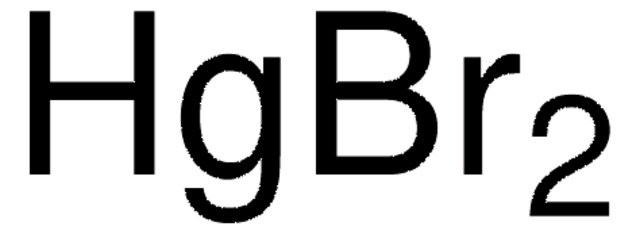200085
Mercury(II) bromide
ACS reagent
Sinônimo(s):
Mercuric bromide
About This Item
Produtos recomendados
grau
ACS reagent
Nível de qualidade
pressão de vapor
1 mmHg ( 136.5 °C)
forma
powder
adequação da reação
reagent type: catalyst
core: mercury
Impurezas
≤0.05% insol. CH3OH
resíduo de redução
≤0.02%
cor
white to very faintly yellow
pb
322 °C (lit.)
pf
236 °C (lit.)
traços de ânion
chloride (Cl-): ≤0.25%
cadeia de caracteres SMILES
Br[Hg]Br
InChI
1S/2BrH.Hg/h2*1H;/q;;+2/p-2
chave InChI
NGYIMTKLQULBOO-UHFFFAOYSA-L
Procurando produtos similares? Visita Guia de comparação de produtos
Descrição geral
Aplicação
Palavra indicadora
Danger
Frases de perigo
Declarações de precaução
Classificações de perigo
Acute Tox. 1 Dermal - Acute Tox. 1 Inhalation - Acute Tox. 2 Oral - Aquatic Acute 1 - Aquatic Chronic 1 - STOT RE 2
Código de classe de armazenamento
6.1A - Combustible acute toxic Cat. 1 and 2 / very toxic hazardous materials
Classe de risco de água (WGK)
WGK 3
Ponto de fulgor (°F)
Not applicable
Ponto de fulgor (°C)
Not applicable
Certificados de análise (COA)
Busque Certificados de análise (COA) digitando o Número do Lote do produto. Os números de lote e remessa podem ser encontrados no rótulo de um produto após a palavra “Lot” ou “Batch”.
Já possui este produto?
Encontre a documentação dos produtos que você adquiriu recentemente na biblioteca de documentos.
Os clientes também visualizaram
Nossa equipe de cientistas tem experiência em todas as áreas de pesquisa, incluindo Life Sciences, ciência de materiais, síntese química, cromatografia, química analítica e muitas outras.
Entre em contato com a assistência técnica













